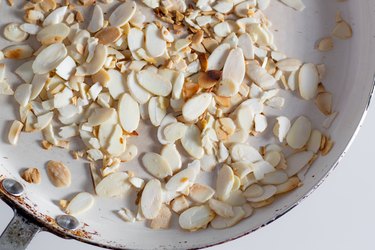
Sliced almonds are a tasty topping that can be added to yogurt, desserts, oatmeal and many other dishes. However, sliced almonds can also be hard to find or expensive. Fortunately, it's not too hard to make sliced almonds at home.
Read more: 9 Healthy Nuts That May Help You Live Longer
Video of the Day
Video of the Day
Making Sliced Almonds at Home
Almonds are a delicious nut, and they're rich in healthy fats. The Harvard T.H. Chan School of Public Health says that almonds are also a good source of fiber, vitamin E, calcium, phosphorus, magnesium and antioxidants.
Whole almonds are fairly common, but flaked and sliced almonds are typically made using special machinery. The machines used for the almonds you'll find presliced at the supermarket aren't made for home use.
Read more: 18 Fat-Rich Foods That Are Good for You
However, it's possible to make your own sliced almonds by hand. According to the Almond Board of California, you'll need to heat your almonds before you slice them. This process is a little more complicated than it sounds, though.
Step 1: Preheat Your Oven
If your oven has a warming setting, preheat it at this setting. If not, you can preheat it on the lowest setting possible. Anywhere between 100 and 170 degrees Fahrenheit (38 and 77 degrees Celsius) should be fine.
Step 2: Blanch Your Almonds
As you know, almonds are crunchy. You need to blanch your almonds before slicing to soften them. If you don't, you'll end up with broken almond flakes.
The University of Missouri Extension defines blanching as the scalding of a vegetable in boiling water or steam. Although this might sound complicated, blanching is easy.
All you need to do is prepare a bowl of ice-cold water and a pot of boiling water. Then put your almonds in a colander in the sink and pour the boiling water over them. Finally, pour the ice cold water over your almonds.
Step 3: Remove the Skin
Although you don't need to, many people prefer to remove the almond skin at this stage. All you'll need to do is rub the skin off of your almonds by moving your fingers back and forth.
If you'd prefer the skin on your almonds, feel free to skip this step. However, it does make it easier to slice them later on.
Step 4: Heat Your Almonds
Put your almonds in the preheated oven. Let them dry, but don't toast them.
Step 5: Slice Your Almonds
Remove the almonds from the oven in small batches. You'll want to slice them when they're warm, so it's important to not remove them all at once.
You'll need to slice each almond vertically with a sharp knife on a cutting board. People often use smaller knives, like paring knives, given the small size of almonds.
You can usually obtain several sliced almonds from each whole almond. You can also use this technique to create almond flakes, which are essentially just finely sliced almonds. However, almond flakes are much more difficult to produce.
Step 6: Store Your Almonds
Eat your sliced almonds or almond flakes right away, or store them in your fridge. An airtight plastic container, resealable bag or glass jar can be used to store the almonds. Storing them this way will help prevent them from going rancid quickly.
If you feel that making sliced almonds or almond flakes is too challenging, you can always make slivered almonds as a substitute. The process for making slivered almonds is basically the same, but you can chop them roughly, which makes creating them easier.
Tip
Besides eating sliced or slivered almonds as a snack, you can incorporate them into delicious recipes such as our Almond and Apple Mixed Greens Salad, Luncheon Chicken Salad Pizza and Curry Coconut Chicken, Cilantro and Almond Oatmeal.